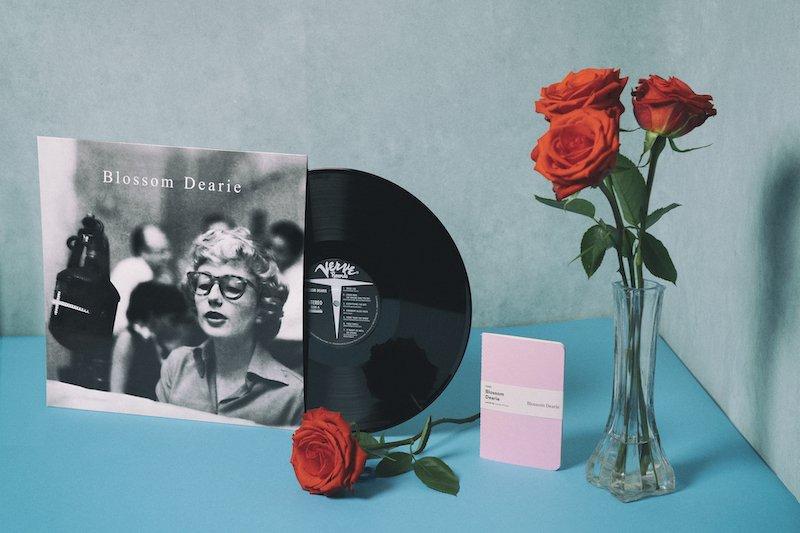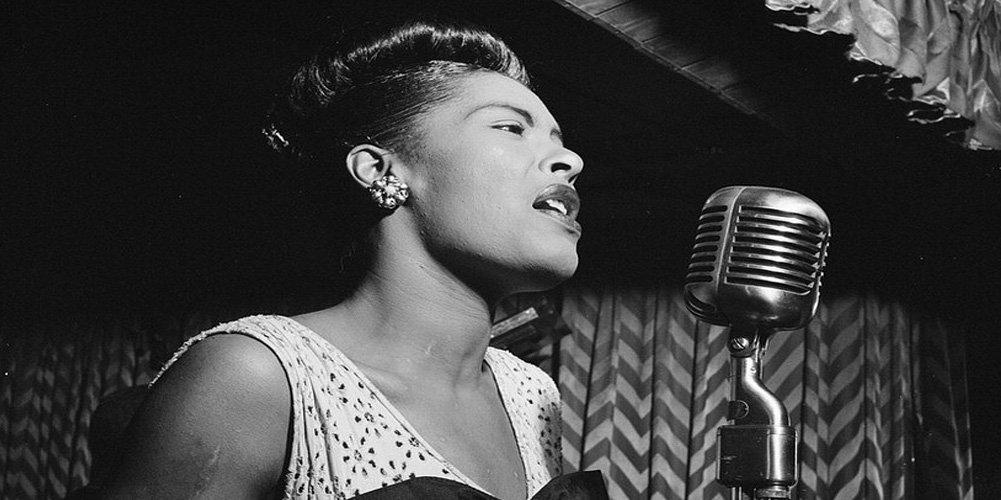Blossom Dearie Was ‘The Only White Woman Who Had Soul’
Read The Liner Notes For Our New Reissue Of The Pianist’s Debut LP
In January, members of Vinyl Me, Please Classics will receive Blossom Dearie, the 1957 Verge debut from jazz pianist Blossom Dearie. It was an album that introduced American audiences to the myriad of charms of Dearie, whose songs would go on to inspire artists like Feist and Norah Jones. It hasn’t been reissued on vinyl in the U.S. since it’s 1957 release. Read more about why we picked this title over here. You can sign up here.
Below, you can read an excerpt from our exclusive Listening Notes Booklet that is included with our edition of Blossom Dearie.
“But Ray Brown told me I was built for speed,” sings Blossom Dearie on “Blossom’s Blues,” one outtake from her self-titled American debut album. It was a classic example of doing the bit before you become someone else’s punchline: Dearie sings the lyric — a wink at her accompanying bassist Ray Brown, whose endorsement was sure to make listeners wind the record back — in the highest, most girlish range of her naturally high and girlish voice, playing into the perceived dissonance between having real jazz bona fides and that kind of voice.
When it came to how she was received, Dearie was always in on the jokes — which often started with her name. “There’s nothing pretentious, or deadly earnest about Blossom Dearie,” wrote Disc of the debut in 1958. “But with a name like that, how could there be?” Almost every interview she did included a query as to whether it was her real name (it was) or one of the “lame attempts at humor to which Miss Dearie is now fairly well resigned, if not numb,” as the original liner notes to this album put it. Then came her voice itself, which The New Yorker referred to as a “childish treble” and a “baby voice” singing “postgraduate lyrics.”
The jokes stopped, though, when it came to assessing her musical ability. Ray Brown’s reported quip aside, Dearie’s success — niche though it might have ultimately been — came from her singular ability to accompany her elegant, straightforward-sung melodies with dynamic and propulsive piano playing. Apocryphally, Miles Davis called her “the only white woman who ever had soul.” But what soul she had, the genuine feeling she was able to impart via mostly faithful renditions of the American songbook, came from her resistance to imitation (of artists black and white alike) in favor of a sound that tied her neither to jazz precedent nor cabaret clichés. On Blossom Dearie, she’s sophisticated but earthy; she’s straightforward and precise but still witty and light. In other words, she’s the sound of New York at its location-shot, cosmopolitan, dry-martini best, thanks to her unique ability to soak up life and art uptown, downtown and everywhere in between.
“I feel like a true New Yorker in the sense that I was born in New York state and live in New York City,” as Dearie put it. Born in 1924, she played piano from a young age growing up in East Durham, a hamlet near Albany; classical lessons were her starting point, but by high school she was playing jazz with a dance band. Singing only became part of her repertoire after moving to the city in the mid-1940s, where she roomed with British singer Annie Ross and — by Ross’s recollection — a stripper named Rusty Lane. Just out of high school, Dearie picked up gigs in tiny clubs as a pianist and in the vocal groups that provided lush harmonies for swinging bandleaders like Woody Herman and Alvino Rey.
But the most important thing about her move was the education she found on the city’s music scene, both from the lounge singers she went to see on the East Side and the beboppers she hung out with in Gil Evans’ basement apartment on the West Side — a musical habitat that ran roughly from one end of 52nd Street to the other. “When I reached New York City, I discovered two different worlds of popular music, both of them using almost the same repertoire of songs,” Dearie once wrote in an autobiographical press release. “If you heard Sarah Vaughan sing “Embraceable You” at Birdland (52nd Street and Broadway), then rushed over to hear Mabel Mercer at the Byline Room (52nd Street and 3rd Avenue), it was like hearing one singer from Mars and another from Pluto. I tried putting them both together.”
According to Dearie, she went to Birdland to hear bebop legends like Vaughan and Charlie Parker every night for three years. That was how she became part of Evans’ inner circle, one of the only women hanging at his 55th Street studio alongside other artists whose work would wind up defining an entire era of American music. “Bebop had a great impact on me,” she told NPR. “We belonged to a kind of a social circle, and we’d meet at parties and things like that. I knew those musicians and loved them very much.” It was in Evans’ basement — where Birth of the Cool was slowly but surely being workshopped — that Dearie met Davis. She recalls that they shared an affection for the Oklahoma! tune “Surrey With A Fringe On Top,” which they both eventually interpreted memorably on wax.
Her first attempts at merging her West Side and East Side worlds came with a few record dates that incorporated scatting and the then-nascent genre of vocalese, in which singers recreate an instrumentalist’s solo note-for-note. Dave Lambert, one of the genre’s pioneers, led her first session in 1948 — Gerry Mulligan did the arrangements. A year later, she joined Stan Getz, Al Haig, and Jimmy Raney to cut two sides for Prestige that featured more wordless, boppish melodies. In 1952 she found her biggest success to that point with an uncredited cameo on singer King Pleasure’s “Moody’s Mood For Love,” based on a solo by saxophonist James Moody. She went back behind the piano later that year to accompany her friend Annie Ross, alongside none other than vibraphonist Milt Jackson, bassist Percy Heath, and drummer Kenny Clarke — what would soon become the Modern Jazz Quartet, with Dearie in place of John Lewis.
Dearie was self-effacing in her insistence that her piano playing was only exactly what was necessary, and that it wasn’t improvised. Yet before the release of her Verve debut, she was more often billed as a pianist than a singer; behind Ross, she fits in easily with Jackson, Heath, and Clarke. If she wasn’t improvising, she still captured an enviable spontaneity and simplicity with her playing — one that earned famous fans. Shortly after Dearie’s passing, pianist Dave Frishberg recalled asking Bill Evans about his use of fourths in chord voicings. “His immediate answer was that he heard Blossom Dearie play that way and it really knocked him out,” wrote Frishberg. “Then he did a little rave review of Blossom, naming her as one of his models of piano playing.” On “More Than You Know,” for example, she doesn’t sing at all, instead outlining the tune with lush, staggering chords that land perfectly offbeat.
By the early 1950s, she’d begun performing alone downtown at the Club Chantilly in Greenwich Village (West 4th Street and 6th Avenue) — but her brand of intimate, jazz-oriented performance was tricky to market and she was struggling. French music producer Eddie Barclay and his wife Nicole heard her perform, though, and convinced her to move to Paris in 1952 to perform and record for his then-nascent label Barclay Records. She had reasonable success, recording her first sides as a leader with vocal group Les Blue Stars with whom she sang, arranged and played piano. The result was swinging pop versions of what were quickly becoming bop standards — their biggest hit was a French version of “Lullaby of Birdland.”
Dearie was wooed back stateside by jazz entrepreneur Norman Granz, who heard her sing in Paris and signed her to a six-album deal with Verve. She returned to New York to record her American debut in late 1956 with Ray Brown, guitarist Herb Ellis, and drummer Jo Jones, quickly becoming the stuff of gossip columns: One mention in early 1957 describes her as looking “very Rive Gauche in a turtleneck sweater and ‘cap’ hairdo.” She started an extended run as one member of a cabaret at New York nightlife legend Julius Monk’s then-new bar Upstairs at the Downstairs (51st Street and 6th Avenue), just as her album was released to mostly rave reviews. The only caution was, according to Billboard, that it “might be too hip for current teen tastes.”
Teens aside, the project earned her a devoted following. Dearie’s precision and skill (and inimitable accompanists) meant its pared-down arrangements and conversational tone still had heft — wispy, featherlight voice and all. She could be serious (“Lover Man”), raunchy and funny (“Everything I’ve Got”), Continental (several French songs, as well as translations of “I Won’t Dance” and “It Might As Well Be Spring”) or simply swinging (“’Deed I Do”). The throughline is a musical wit that never turns into cynicism, framed by pitch-perfect phrasing that Dearie and her band make sound easy.
Her Verve projects would only grow more refined and timeless, but Blossom Dearie lays out Dearie’s basic mission: music that transports the listener to a room where she herself might be singing directly to them, the kind of intimate room that now feels lost to another time and place. It’s no wonder her records, with their specific yet classic sound, have become common in movie and TV soundtracks (and less glamorously, Starbucks playlists) — they’re a cheat-code for sophistication that doesn’t take itself too seriously. Or just for the city where people come to try to find that trait in themselves; as critic Terry Teachout put it while she was still alive, “She’s the New Yorkiest thing in New York.” Dearie saw herself as the bridge between two worlds: East Side and West Side, cabaret and jazz, and, less explicitly, black and white. What could be more New York than that? “Here I am still sitting on that boundary line,” she wrote of creating her own lane, “loving every minute of it.”
Natalie Weiner is a writer living in Dallas. Her work has appeared in the New York Times, Billboard, Rolling Stone, Pitchfork, NPR and more.
Related Articles
Join the Club!
Join Now, Starting at $36Pages







